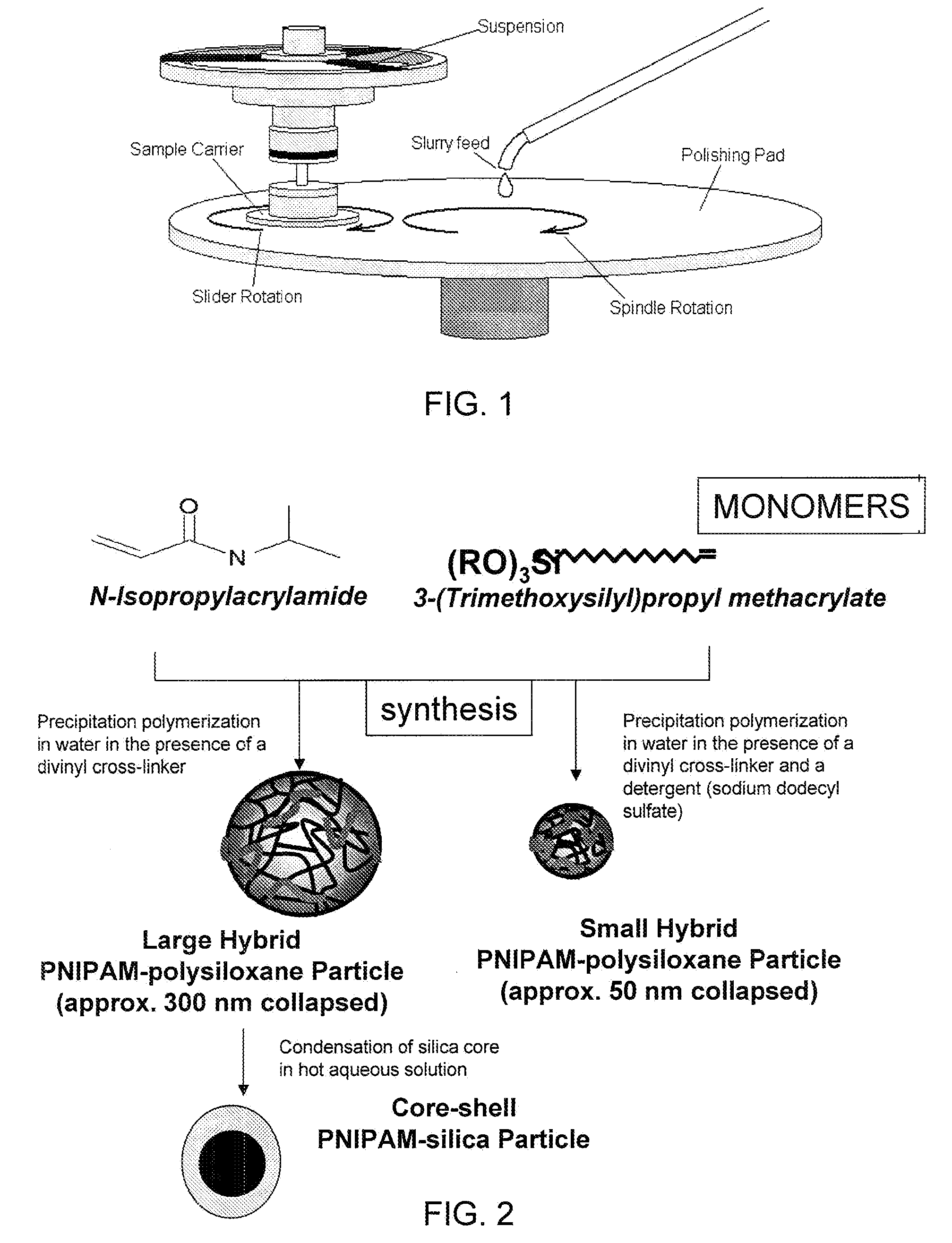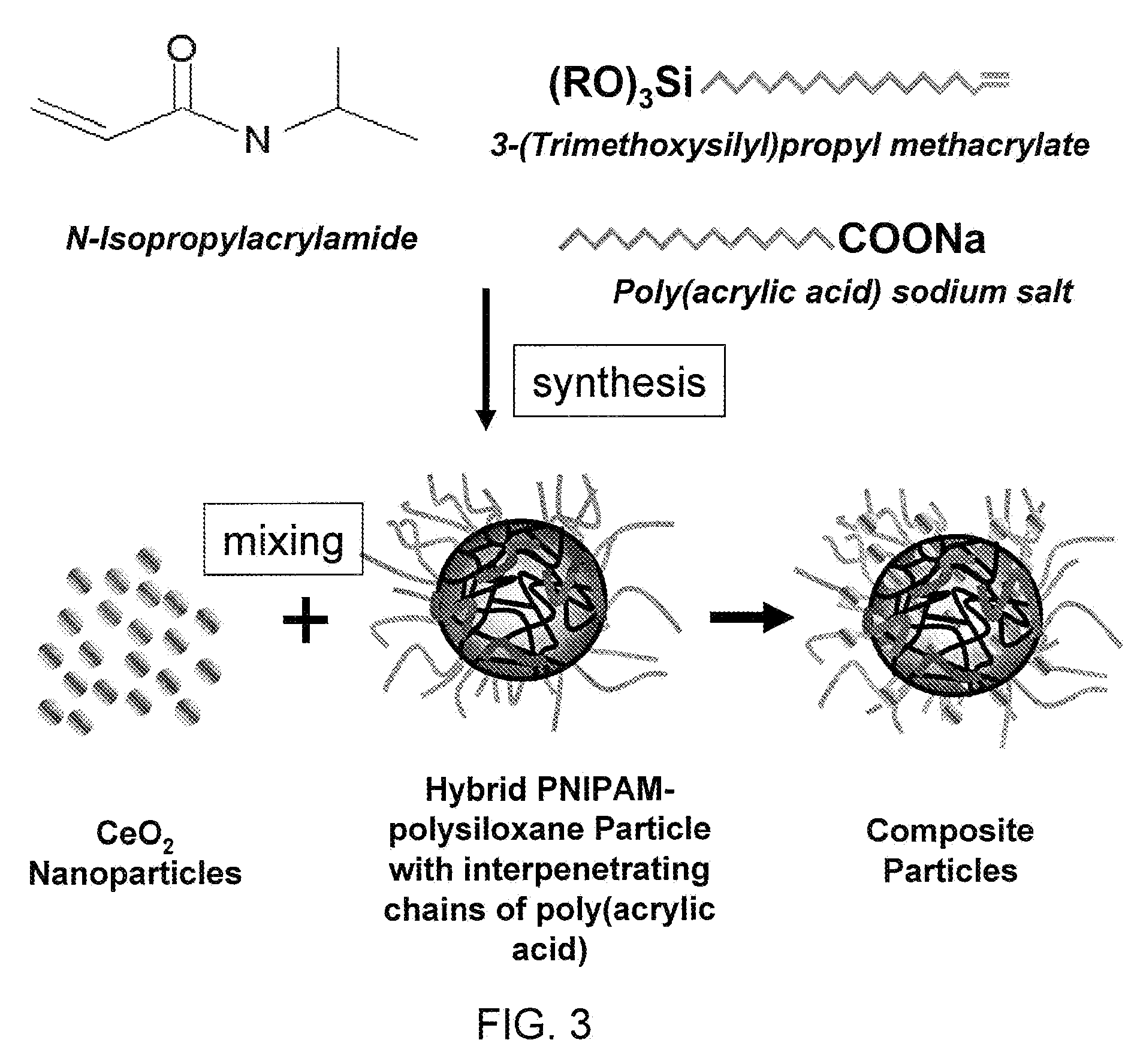Polymeric Microgels for Chemical Mechanical Planarization (CMP) Processing
a technology of mechanical planarization and polymer microgels, which is applied in the field of chemical mechanical planarization (cmp), can solve the problems of surface scratches on the surface of the wafer, electrical short circuits, and the requirement for post-cmp surface quality and defects becoming more critical, and achieves low mechanical stress, desirable removal rate, and low down force
- Summary
- Abstract
- Description
- Claims
- Application Information
AI Technical Summary
Benefits of technology
Problems solved by technology
Method used
Image
Examples
example i
[0065]N-Isopropylacrylamide (NIPAM) that was previously recrystallized in hexane, was dissolved in DI water to which a divinyl cross-linker, N,N′-Methylenebisacrylamide was added. The solution was bubbled with nitrogen gas, to displace oxygen after which the polymerization was initiated at 75° C. with the ionic initiator Potassium Persulfate. Two hours after initiation, 25 wt % (as that of the total NIPAM) of the co-monomer, 3-(Trimethoxysilyl)propyl methacrylate was added to the reaction mixture and the polymerization allowed to continue for a further 1 hr 45 mins. The product obtained was centrifuged at 7000 RPM and washed with deionized water three times to remove oilogmers, unused reactants and side products. The resulting hybrid PNIPAM-polysiloxane material was characterized using Fourier Transform Infrared (FTIR), Dynamic Light Scattering (DLS) and Transmission Electron Microscopy (TEM). These particles were then used for chemical planarization on CETR bench top tester.
[0066]C...
example ii
Composite PNIPAM-Polysiloxane-Ceria Particle
[0077]Another type of particle developed was a composite of PNIPAM-polysiloxane-Ceria. Ceria (CeO2) has been known to yield excellent removal rates for silicon oxide during chemical mechanical planarization. Nanoparticles of ceria were evenly dispersed within the microgel framework as shown in the TEM image in FIGS. 18 and 19. The ceria was incorporated in to the microgels using interpenetrating chains of polyacrylic acid (PAA) that are known to functionalize the inorganic oxide surfaces (see our publication in Journal of Colloid and Interface Science)
[0078]Interpenetrating chains of PAA were incorporated in the hybrid PNIPAM-polysiloxane particles by mixing poly(acrylic acid) sodium salt (Mw ˜15,000 g / mol) in the initial reaction mixture of NIPAM in DI water in ratio of 2 to 1 by weight (as to the total NIPAM content). After purification, a solution of the hybrid particles was mixed with a suspension of nanoparticles of CeO2 (Sigma-Aldric...
example iii
[0084]In another embodiment, composites of the polymer microgels were made with nanoparticles of titania (TiO2) to illustrate that the novel particles can be extended to other metal oxide materials.
[0085]Interpenetrating microgels were formed by the surfactant free precipitation polymerization of NIPAM (1 g) in an aqueous solution (200 ml) containing poly(acrylic acid) sodium salt (1.5 g, Mw >>15,000 g / mol). MBAA (0.04 g) was used as the cross-linker and KPS (0.02 g) served as the initiator. Following purging with N2, the reaction mixture was heated in an oil bath to 75+C and the initiator was added. After polymerization for 5 h, the product was cleaned by washing and centrifuging three times.
Preparation of Interpenetrating Microgel-TiO2 Composite
[0086]Nanoparticles of TiO2 powder (commercially available or laboratory synthesized ultrafine particles) were suspended in deionized water with the pH adjusted to 1.5 using 37% v / v HCl to maintain a positive charge on the particle surface....
PUM
| Property | Measurement | Unit |
|---|---|---|
| Responsivity | aaaaa | aaaaa |
| Hydrophilicity | aaaaa | aaaaa |
| Surface roughness | aaaaa | aaaaa |
Abstract
Description
Claims
Application Information
 Login to View More
Login to View More - R&D
- Intellectual Property
- Life Sciences
- Materials
- Tech Scout
- Unparalleled Data Quality
- Higher Quality Content
- 60% Fewer Hallucinations
Browse by: Latest US Patents, China's latest patents, Technical Efficacy Thesaurus, Application Domain, Technology Topic, Popular Technical Reports.
© 2025 PatSnap. All rights reserved.Legal|Privacy policy|Modern Slavery Act Transparency Statement|Sitemap|About US| Contact US: help@patsnap.com



